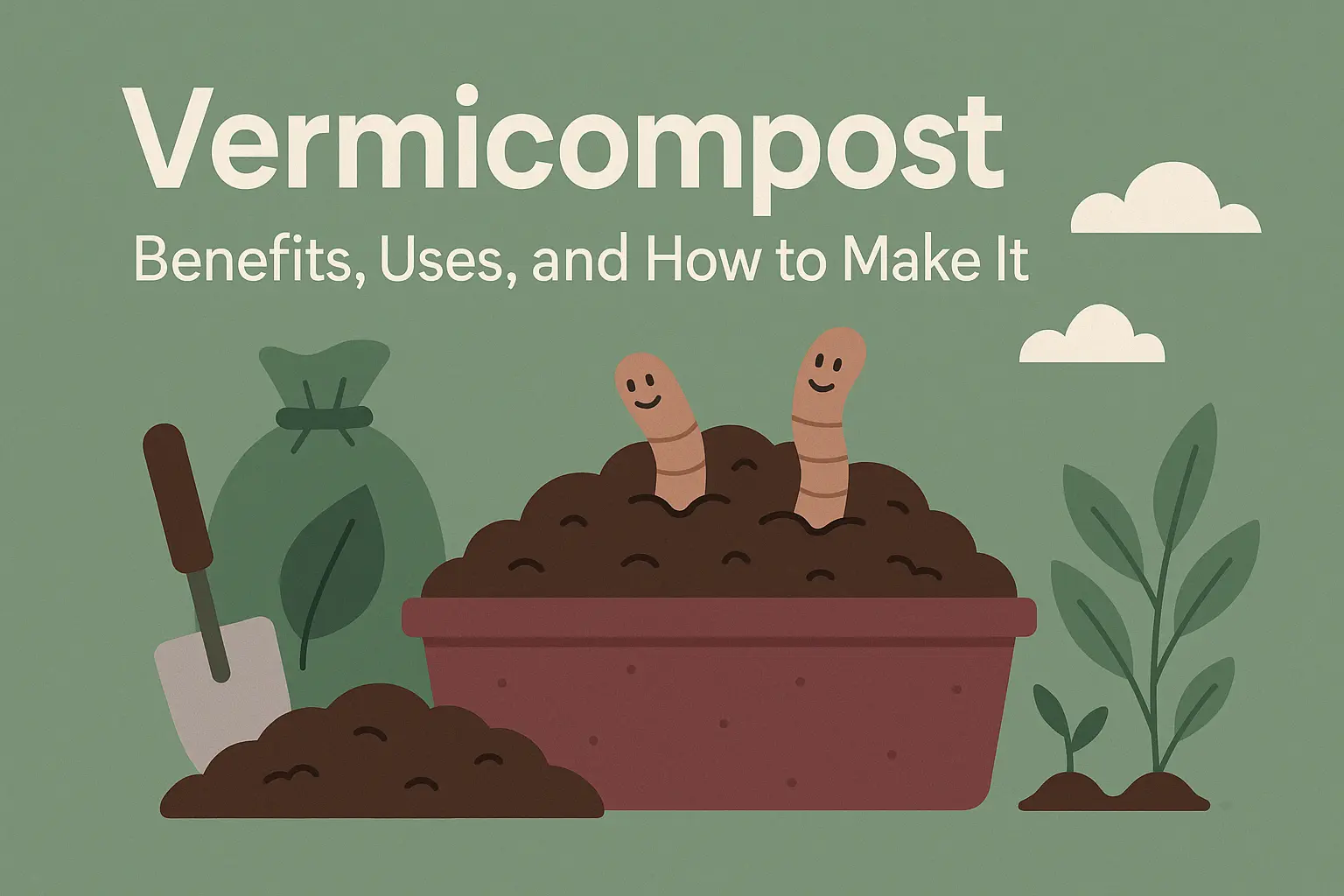Vermicompost: Benefits, Uses, and How to Make It – A Complete Guide by NuroFarm

Vermicompost is one of the most powerful tools in sustainable farming. It improves soil health, boosts plant growth, and supports long-term productivity—without the side effects of chemical fertilizers. At NuroFarm, we’re committed to helping farmers get back to the roots of natural cultivation. In this detailed guide, you’ll learn everything about vermicompost: how it works, how to make it, how to use it, and why more farmers are switching to it every season.
🪱 What is Vermicompost?
Vermicompost is a type of organic fertilizer created by the breakdown of organic waste using specific species of worms—mainly red wigglers. These worms eat decomposing vegetable scraps and release waste (called castings) that’s rich in nutrients and beneficial microbes.
It looks like dark, fine, soil-like material. But it’s more than just compost. It’s a microbial powerhouse that improves soil structure, plant immunity, and nutrient uptake.
Simple definition: Vermicompost is worm-processed organic matter that improves crop health and soil fertility.
🌿 Why Vermicompost Matters in Farming
Soil is more than just dirt. It’s a living system. Decades of chemical fertilizer use have harmed this system, making soil compact, lifeless, and dependent on artificial inputs. Vermicompost restores soil life.
Here’s why it matters:
- Saves costs over time: You use less water, fewer chemical sprays, and no soil conditioners.
- Improves yields: Plants absorb nutrients better when the soil is alive.
- Reduces plant stress: Strong roots make crops resistant to drought and disease.
Whether you’re farming on 1 acre or managing a backyard garden, vermicompost gives your soil a fresh start.
🔧 How is Vermicompost Made? (Step-by-Step Guide)
You don’t need fancy equipment or high-tech tools. Vermicompost can be made using simple, low-cost materials.
🔸 Materials Required:
- Container: Large bin or wooden box with small holes for air and drainage
- Bedding material: Shredded newspaper, coconut coir, dry leaves
- Worms: Eisenia fetida (red wigglers)
- Organic waste: Vegetable peels, fruit scraps, tea leaves, eggshells
🔸 Step-by-Step Process:
1. Prepare the container
Choose a plastic or wooden bin and make holes at the base for drainage and air. Place it in a shaded, cool area.
2. Add bedding
Start with a 4–6 inch layer of bedding material. This helps absorb excess moisture and gives worms a place to burrow.
3. Introduce the worms
Add red wigglers on top of the bedding. Give them time to settle for a few hours.
4. Feed the worms
Add chopped kitchen waste in small amounts every 2–3 days. Avoid overfeeding and mix food with bedding to prevent smell.
5. Maintain moisture
Keep the bin as moist as a wrung-out sponge. Too much water causes rot; too little dries the worms.
6. Turn occasionally
Every 7–10 days, gently turn the mix with a stick or fork to allow airflow.
7. Harvest after 6–8 weeks
When the bin has mostly dark, fine material and fewer visible food scraps, your vermicompost is ready.
🚫 What Not to Add:
- Dairy, meat, oily food
- Citrus and spicy food
- Plastic, glass, or non-biodegradable waste
These items either harm the worms or slow down decomposition.
🌱 Top 7 Benefits of Using Vermicompost
Vermicompost is more than just a fertilizer. It’s a soil conditioner, plant booster, and eco-solution in one. Here’s how it helps:
1. Improves Soil Texture
Loosens hard soil, allowing better root growth and aeration.
2. Increases Microbial Activity
Worm castings are full of beneficial microbes that break down nutrients and make them available to plants.
3. Rich in Plant Nutrients
Contains available nitrogen (N), phosphorus (P), potassium (K), calcium, magnesium, and trace minerals.
4. Boosts Water Retention
Helps sandy soils hold water longer, reducing the need for frequent irrigation.
5. Strengthens Plant Immunity
Crops grown with vermicompost are more resistant to fungal infections and pest attacks.
6. Safe and Organic
No chemical residues. Safe to use on all types of crops, including fruits, vegetables, and flowering plants.
7. Environmentally Friendly
Reduces landfill waste, cuts down on synthetic inputs, and supports zero-waste farming.
🌾 Real-World Results: NuroFarm Case Study
At NuroFarm, we tested vermicompost on tomato and okra crops in Punjab over 2 crop cycles.
Results:
- Yield increased by 18%
- Soil organic carbon improved by 22%
- Reduction in fungal disease by 30%
- Fertilizer cost reduced by 15%
Our farmers noticed better root strength, stronger stems, and faster flowering. More importantly, they saw long-term soil health returning—something no chemical fertilizer could offer.
🧪 How to Use Vermicompost in Farming and Gardening
You can use vermicompost in multiple ways. Here’s how to apply it for best results:
📌 Field Crops:
- Mix 2–3 tons per acre into the topsoil during land preparation.
- Use before sowing or just before irrigation.
📌 Vegetables & Fruit Plants:
- Add 1–2 handfuls around the root zone of each plant.
- Repeat every 15–20 days during growth stages.
📌 Potted Plants & Home Gardens:
- Mix 25–30% vermicompost with existing soil.
- Add a handful every month as top dressing.
⚠️ Tips for Best Results:
- Do not expose fresh vermicompost to harsh sunlight.
- Always apply in moist soil.
- Combine with mulching to retain nutrients.
🛒 Where to Buy Quality Vermicompost?
NuroFarm offers premium-grade vermicompost made from 100% organic inputs. It is:
- Lab-tested for nutrient balance
- Packaged with zero plastic leakage
- Available in 5kg, 10kg, and bulk sacks
You can purchase directly from our dealers or contact us for custom farm supply plans.
👉 Explore Vermicompost Options from NuroFarm
📞 WhatsApp Support | 📦 Delivery Available Across India
✅ Conclusion: Small Input, Big Impact
Vermicompost is one of the easiest changes you can make to improve your farm’s output. It requires no chemicals, supports healthy soil, and gives plants the exact nutrients they need.
At NuroFarm, we encourage farmers to move towards smarter, cleaner practices—and vermicompost is at the center of this shift.
Try it. Test it. Compare the difference.
Want to start with a small batch or buy in bulk?
Contact our team today and let’s build healthier soil together. version, or do you want a specific tone tweak or design asset next?
❓ FAQs: Your Questions Answered
Q1. What is vermicompost used for?
A: It’s used to improve soil quality, promote healthy crop growth, and reduce chemical inputs in farming.
Q2. How do I make vermicompost at home?
A: Use a bin, bedding material, kitchen waste, and red wigglers. Follow the step-by-step guide shared above.
Q3. Can vermicompost replace chemical fertilizers?
A: Yes, in most cases. It provides slow-release nutrients and supports natural soil health. For heavy feeders, it can be supplemented with organic nutrient blends.
Q4. Is it safe for all plants?
A: Yes. It’s non-toxic and suitable for vegetables, fruits, ornamental plants, and lawns.
Q5. What’s the shelf life of vermicompost?
A: If stored in a cool, dry place, vermicompost can last up to 6 months without losing quality.

